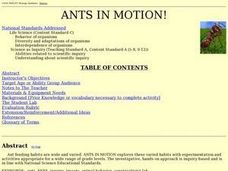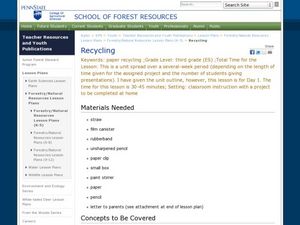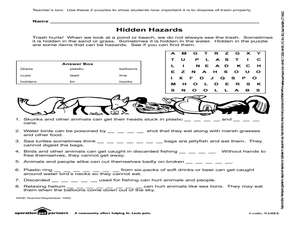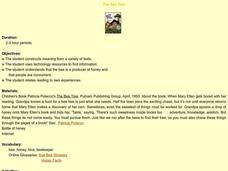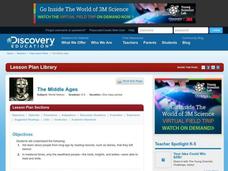Curated OER
Inventors
Students brainstorm a list of inventions that have affected their lives. In groups, they use the internet to research a specific inventor and their invention. They use the information to write two paragraphs and share their information...
Curated OER
Environmental Action
Students investigate an environmental problem in order to find and propose possible solutions. The problem is real to add to the engagement of the lesson plan. This is found through conducting research and then brainstorming is done in...
Curated OER
Interdependence and adaptation
Students use keys to identify animals and plants in local habitats. Students are asked if they remember what the word habitat means. Students make a list of three different local habitats and brainstorm animals and plants they might...
Curated OER
Ants In Motion
Students brainstorm ants and their characteristics in a class discussion. They observe the ants and answer question pertaining to their behavior; then they apply the scientific method in creating and investigating a problem.
Curated OER
Where The Wild Things Are
Twelfth graders brainstorm where they think wild things exist. Then using the same strategy they discuss natural surroundings from using prior life experience. This part of the lesson can also be done with using a nature hike. Students...
Curated OER
Lessons from The Lorax
Learners read and watch a video of The Lorax by Dr. Suess. As a class, they answer a set of questions about how the environment was affected by industries. They also brainstorm a list of possible solutions to help curb the pollution.
Curated OER
Campus Nitrogen Budget
Students are given guidelines to college level nitrogen budgeting. Students brainstorm the campus links to nitrogen budget. Students pick topics or subtopics for individual or group research. Students develop research plan, keep good...
Curated OER
Children's Literature Across the Curriculum Ideas: Chickens Aren't the Only Ones
Young scholars read Chickens Aren't the Only Ones by Ruth Heller. They complete a variety of cross-curricular activities surrounding the study of animals that come from eggs. Included are reading, art, math, science, writing, social...
Curated OER
Paper Internet Scavenger Hunt
In this science worksheet, students conduct Internet research to answer 15 questions about the history and process of papermaking. They also write an essay explaining how to make paper.
Curated OER
Nutrition
Students explore nutrition. In this science lesson plan, students identify and describe the main nutrients in our diets that are needed by the body as a source of energy.
Curated OER
The Vibrational Nature of Sound
Students explore the vibrational nature of sound. In this science lesson plan, students gain an understanding of sound frequency, pitch, and conduction using the string telephone, tuning fork and musical glasses experiments.
Curated OER
Summer Camp in the Classroom
Students explore wildlife plants and summer activities. In this natural science lesson, students identify plants and animals and create a scrapbook of their findings.
Curated OER
Recycling: Creative Uses for Items
Third graders list creative uses for old objects. In this recycling lesson, 3rd graders work in groups to brainstorm creative, new uses for old, everyday items. This is the first lesson in a unit on recycling.
Curated OER
Hatching Chickens
Students observe caring for eggs and chickens. In this hatching lesson students brainstorm what they know about chickens and carefully watch what happens.
Curated OER
Three States of Matter
Students explore the three states of matter. In this matter lesson, students are shown a variety of examples and decide whether it is a liquid, solid or gas. Students brainstorm what characteristics the objects in each group share.
Curated OER
Investigating Our Past: Where Did Humans Come From?
Students brainstorm about evolution and explore the processes of evolution. In this investigative lesson students map out evolution and compare the two theories after researching them.
Curated OER
Making a Battery and Energy Transformation
Seventh graders determine what makes a battery work. In this battery lesson, 7th graders brainstorm ideas about how they think batteries provide energy. They perform an experiment in which they work as a team to assemble a battery. They...
Curated OER
Save the Earth: It's Everyone's Home!
Students research ways to conserve and reduce energy and resources. In this reducing waste lesson, students work in teams to experiment with water and losing resources. students brainstorm about ways to conserve and reduce energy and...
Curated OER
Let's Clean Up Our Act and the Earth!
Students complete activities that help clean up the Earth and protect the environment. In this Earth protection lesson, students go outside and listen to the environment. Students discuss their observations and their role in protecting...
Curated OER
Rocks and Minerals
Students identify how weathering and erosion effect the Earth's surface. In this weathering and rocks lesson, students study various types of rocks in water and brainstorm ways the Earth's surface changes. Students view an interactive...
Curated OER
The Bee Tree
Young scholars practice reading comprehension by reading a book in class. In this story map lesson, students read The Bee Tree by Patricia Polacco, and create a story map based on the problem and solution of the book. Young scholars...
Curated OER
The Middle Ages
Students discuss the Middle Ages. In this social science lesson, students role-play that they are medieval lords, knights, and ladies who keep diaries. Students write what they would have put in their diaries and decorate their diaries.
Curated OER
What Foods Contain Products from the Ocean
Fifth graders learn about foods from the ocean. In this ocean products activity, 5th graders brainstorm what foods come from the ocean, fill in a Venn Diagram comparing alginates, carrageenans and beta carotenes. Students make a list...
Curated OER
How Much Energy Does the Earth Receive from the Sun?
Students explore energy. For this science lesson, students conduct an experiment in which they measure how much energy is produced by the sun. Students build a calorimeter to measure the amount of energy.





